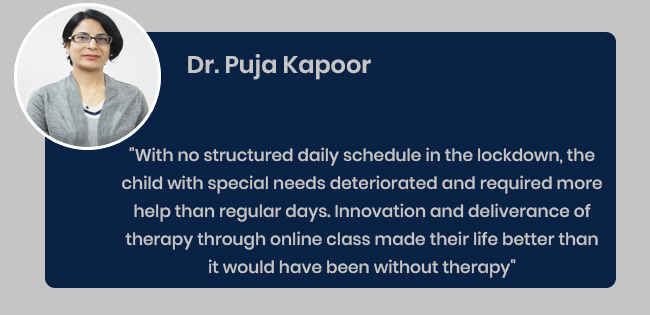
Before the onset of COVID, therapeutic interventions for special needs children were majority done at the therapy center or at home by a therapist. As COVID stuck and the lockdown was imposed, everything which required human contact was shut down. During this tumultuous time, e-connectivity and the use of technology came to the rescue. From therapy to classes, to teaching to counseling, everything shifted to online. This mode of therapy had both pros and cons attached to it that Dr. Puja Kapoor, Paediatric Neurologist & Co-founder of Continua Kids has explained in this article.
Table of Content:-
Pros of Online Therapies
If you are a parent to a child with special needs, here are some advantages of online therapies for you:
- The responsibility of the caregivers increased immensely. Now instead of just driving the child to the therapy center, they had to actually execute the task on the child, under the guidance of the therapist, who is supervising on the screen.
- Because of this, they become more knowledgeable and informed about the process and core science of the activity.
- The execution of the activity helped them to better understand the concept and context of the task.
- It made them well versed with the technical words.
- They became more confident in handling their children and his/her different situations like tantrums, meltdowns, and sensory needs.
- As more and more material related to diagnosis, management, the treatment protocol was shared through webinars, short videos, the awareness about the developmental delay, autism increased in the general population.
- Because of the penetration of social media to the interiors of the country, more and more parents came to know the difference between speech delay and autism.
- Their knowledge about diagnostic terms like ADHD and autism increased manifold.

Many small towns in the country did not have occupational therapists, pediatric neurologists or other subspecialties for diagnosis and management of special needs children. But through online classes, they got to know the subject better which helped in bringing positive changes in the child.
Also Read: Digital Health Is The Future Of Healthcare, Know Its Pros
Cons of Online Therapies

- As online therapy was the only modality left for therapeutic intervention, a lot of innovation took place in this aspect. Online classes became more organized and adaptive to the child’s needs.
- A systemic pattern for teaching and execution developed over time in the lockdown. But definitely, nothing could replace the actual touch of the therapist.
- Still, even after so much progression in online classes, it cannot replace the actual physical evaluation both in the diagnosis and treatment.
- The therapies were designed based on the information provided by the parents which may have some lacunae.
- Certain therapies like physiotherapy, which has more technical aspects to them are very difficult to be imparted through online classes.
- The therapist has to feel the tone, power of the muscle to design a plan, which is not possible in an online class.
- Similarly to have an in-depth knowledge of the child's behavior, a therapist has to observe the child for hours, which is not truly possible by video snippets that were sent by the parents to the therapist for an assessment.
Also Read: Are You Continually Online? Here Are The Mental Health Effects Behind It
Even though online classes were not a perfect replacement for physically oriented sessions, but they were much better than doing nothing for the child. With no structured daily schedule in the lockdown, the child with special needs deteriorated and required more help than regular days. Innovation and deliverance of therapy through online classes made their life better than they would have been without therapy.
Read More Articles in Tips for Parent
Also watch this video
How we keep this article up to date:
We work with experts and keep a close eye on the latest in health and wellness. Whenever there is a new research or helpful information, we update our articles with accurate and useful advice.
Current Version